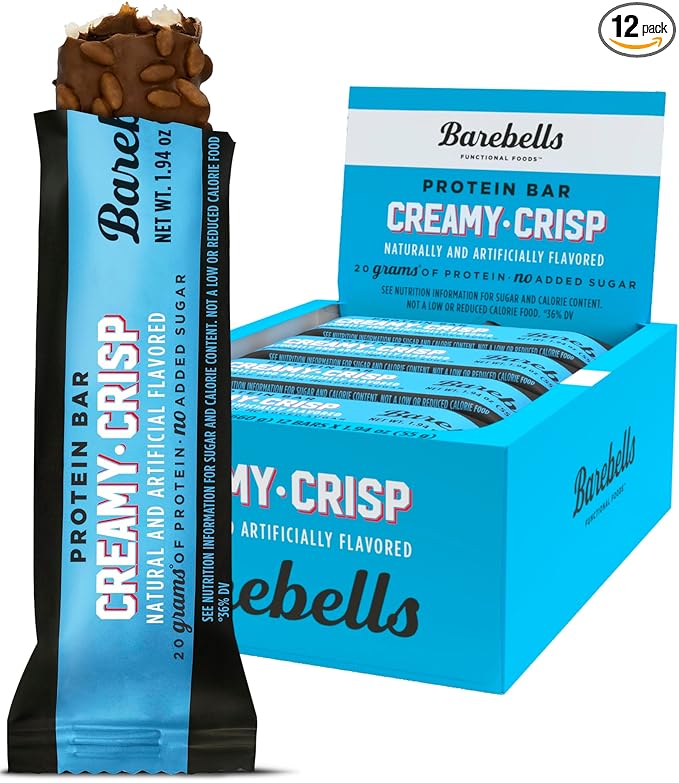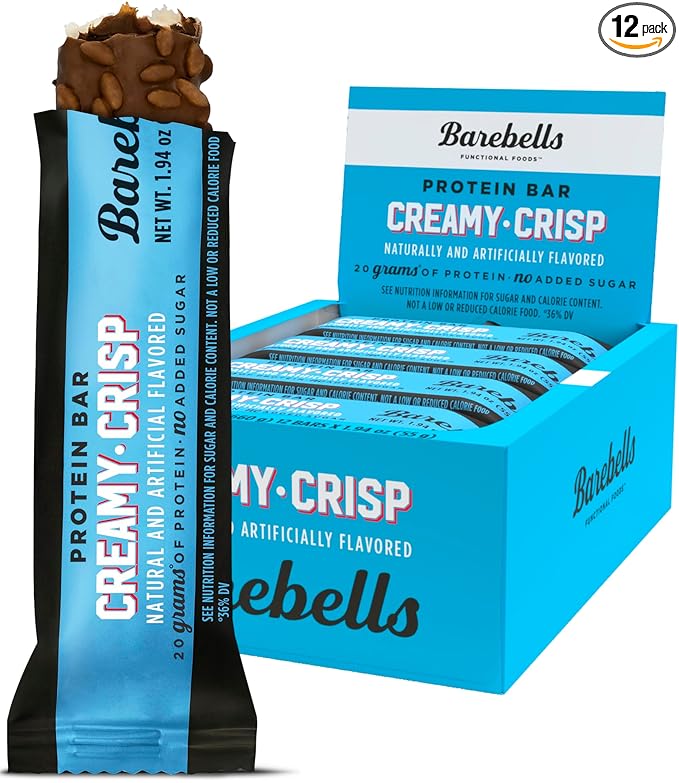Barebells bars are some of the most popular protein bars out there. Founded in Sweden in 2016, the company is widely popular in Europe but has also made its way to the US.
Barebells protein bars are especially known for two selling points: being high in protein and having no added sugar. These two claims make many fitness enthusiasts wonder: are Barebells bars healthy?
We all know that a high protein diet and low consumption of added sugars are some of the cornerstones for health, but does that automatically make Barebells the best protein bar choice out there?
The whole Barebells protein bar range has various tasty flavors, but for the sake of this review, we’ve chosen one of their products to put under the nutritional microscope: Creamy Crisp.
Though other Barebells bars may have slightly different ingredients, the main nutritional information is still the same, including their main ingredients. We still urge you to explore their ingredient list and nutrition facts before purchasing, as they may change over time depending on the exact product.

Barebells Bars: Main Nutrition Facts

Regular Barebells protein bar weighs 55 grams and packs a massive protein punch. They aren’t kidding when they’re calling their bars high-protein: each bar has 20 grams of protein.
In general, foods that have over 10 grams of protein per 100 grams can be called great protein sources, and the same applies to Barebells.
There are hundreds of protein bars out there claiming to be high in protein while having under 10 grams of protein per 100 grams. Barebells protein bars, however, are the opposite, and that’s one of the things we can commend them for.
One Barebells protein bar has 200 calories, making it a proper snack between your main meals. It even has a fair amount of fiber: 3 grams per one protein bar.
Since it has 19 grams of carbohydrates, it may not exactly fit into a Keto diet, but we definitely can’t deny it’s a high-protein snack. (You can still fit it into a Keto diet, too, of course, if you keep all of your meals and snacks extremely low in carbohydrates).
Note that Barebells bars may also have a significant amount of saturated fats: 3.5 grams per bar, or about 18% of the daily saturated fat intake.
For its significant protein content and a rather high amount of calcium, however, Barebells bars definitely lead the way in high-protein bars.
Ingredients in Barebells Bars
If we only look at the nutrition facts behind Barebells bars, they sure sound great. But that’s not the whole story. You also need to be wary of the ingredients, some of which may not be exactly preferred.
Ingredients in Barebells Creamy Crisp:
- Milk protein blend (calcium caseinate, whey protein isolate, whey protein concentrate)
- Glycerin
- Bovine collagen hydrolysate
- Maltitol
- Polydextrose
- Cocoa butter
- Water
- Dry whole milk
- Unsweetened chocolate
- Soy protein isolate
- Sunflower oil
- Natural and artificial flavors
- Tapioca starch
- Salt
- Sunflower lecithin
- Sucralose
Sweeteners in Barebells Protein Bars
The main cause of concern and one of the reasons Barebells protein bars may not be exactly healthy are the artificial sweeteners maltitol and sucralose.
Sucralose is especially problematic as it has been linked with numerous health issues and side effects in several studies. A study published in 2023 raised some issues regarding sucralose and even said that the findings “raise significant health concerns regarding the safety and regulatory status of sucralose itself”.
Main issue with sucralose? Researchers have found it may damage our DNA and impair the gut barrier, leading to a leaky gut.
The side effects and potential dangers of sucralose are not new information, however. A study from 2013 already explored biological issues related to sucralose and concluded that sucralose may be mutagenic, cooking with sucralose may create toxic compounds and it may also alter our glucose and insulin levels.
After all, when choosing sugar alternatives, you’re probably looking to avoid issues with insulin, yet sucralose may not do much good.
The other sweetener in Barebells bars – maltitol – has so far been found relatively safe for human consumption, at least in smaller amounts. But even maltitol may cause some digestive discomfort, similar to all sugar alcohols.
Sucralose, however, is the main reason why we can’t call Barebells protein bars healthy. Consuming added sugars in their natural form – like having coconut sugar, cane sugar, or honey in your meals – may be much better for your health in the long run, considering the side effects sucralose may have.
Are the Proteins in Barebells Bars Safe?
Coming back to the actual protein content in Barebells bars, it’s one of its better features. The Creamy Crisp bar (and several other Barebells variations) is based on a milk protein blend. In other words, the protein bar combines several proteins: calcium caseinate and whey protein.
Though bad news for vegans, this protein combination is actually rather beneficial.
Both calcium caseinate and whey protein are safe, and most people don’t experience any side effects. If anything, you may have some digestive discomfort: some people may have diarrhea, nausea, or constipation from whey protein, mainly when consuming it in bigger amounts. Other than that, the proteins used in Barebells bars are generally considered safe.
And even better news: calcium caseinate is easily absorbed by the body, same goes for whey protein. Whey protein is excellent when it comes to protein intake: it’s known for its rapid absorption rate (around 10 grams per hour). For this exact reason, whey protein has become a popular protein form, especially after a workout session.
Natural and Artificial Flavors in Barebells: What Does That Mean?
We aren’t too happy with Barebells bars due to sucralose already, but we have another bone to pick: natural and artificial flavors. It’s one of the most vague and controversial issues in the food industry, and unfortunately, it doesn’t bring anything too great for consumers.
First, both natural and artificial flavors are actually created in a lab, as Food and Drug Administration spokesperson Deborah Kotz explained. The main difference: natural flavors come from “food” sources, while artificial flavors can be derived from petroleum and some other inedible substances.
Second, since the wording is so vague, you won’t actually know what flavorings have been used in the protein bar. All substances used must fall under the US regulation that lists all synthetic flavorings: all of those have been generally recognized as safe in food, but that doesn’t automatically mean you’re dealing with healthy ingredients.
The whole list of allowed synthetic substances is vast, and unfortunately, in the case of Barebells protein bars, you don’t actually know what you’re consuming.
The best nutrition practice is to avoid any artificial flavors in your food, especially if you’d like to find the healthiest products possible.
Verdict: Are Barebells Protein Bars Healthy?

Barebells Protein Snacks Bars Creamy Crisp
– Good for a quick protein fix: 20 grams of protein per bar
– Barebells high protein bars are famous for soft texture and mouth-watering flavors
– Available in many flavors, each resembling a chocolate bar
Barebells protein bars have their advantages and disadvantages. From one side, Barebells excels in its protein content: 20 grams per bar is phenomenal, plus the actual protein used has a great absorption rate and a minimal risk for side effects.
On the other hand, Barebells ingredients have some health concerns, mainly due to sucralose, which may pose significant health dangers. The use of ‘natural and artificial flavors’ doesn’t do Barebells any favors either since you don’t actually know what you’re consuming. Avoiding artificial ingredients and opting for natural foods is always the smart choice.
But taste-wise, we can understand the phenomenon of Barebells bars – they truly do taste amazing, exactly like a candy bar. For a second, you may forget you’re eating a protein bar. The sweet, chewy, soft texture reminds you of any chocolatey goodies.
Quite possibly, Barebells protein bars are some of the best-tasting ones out there, but remember: there’s more behind protein bars than their protein content and taste. Remember to read the ingredient list and consider the possible health risks posed by some of the ingredients found in Barebells.








